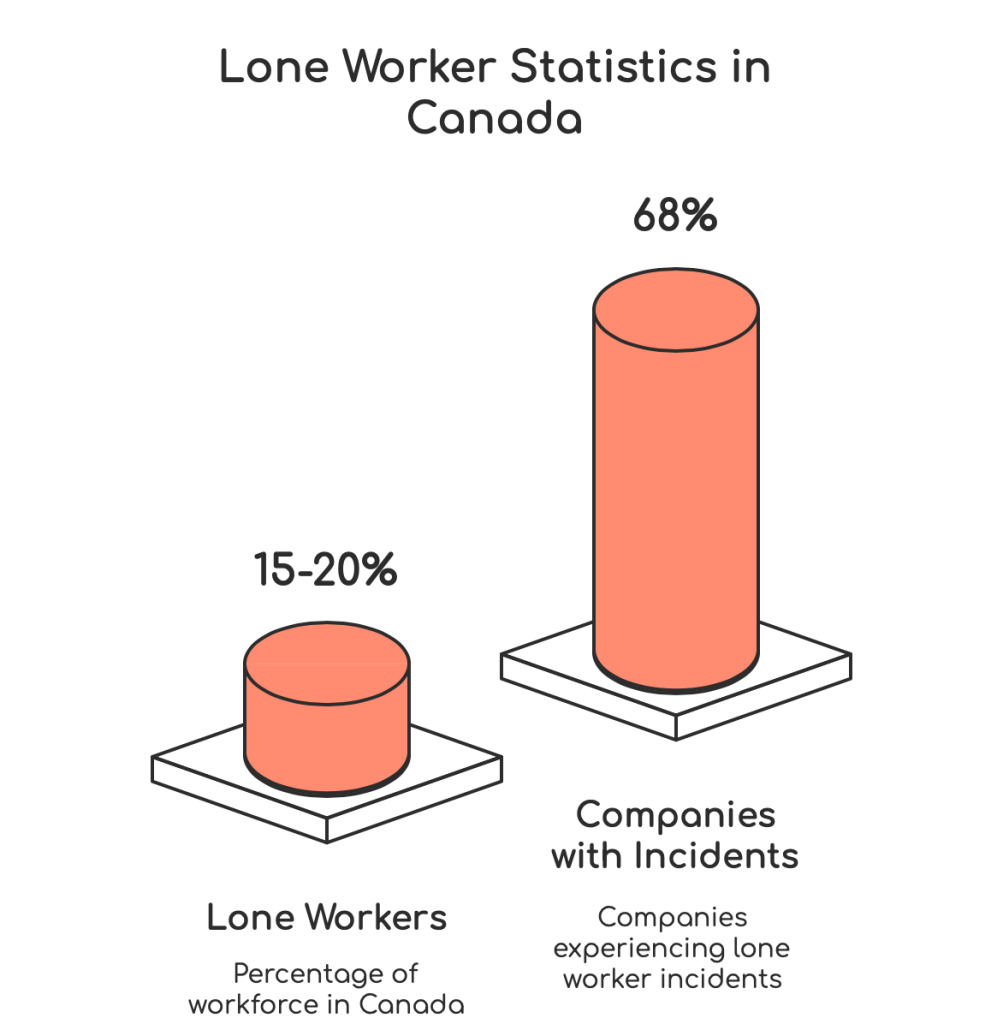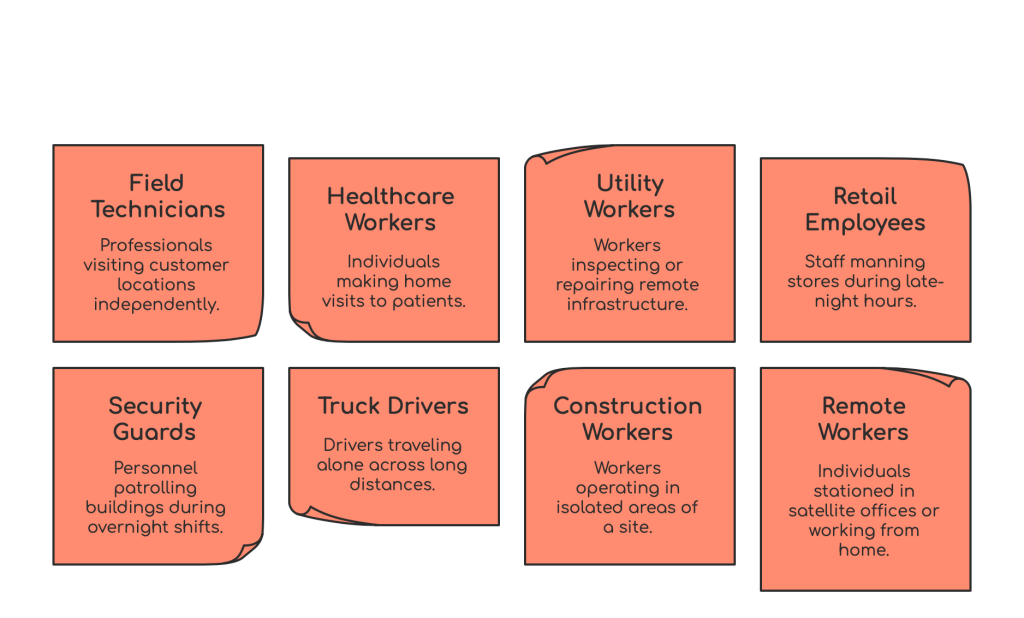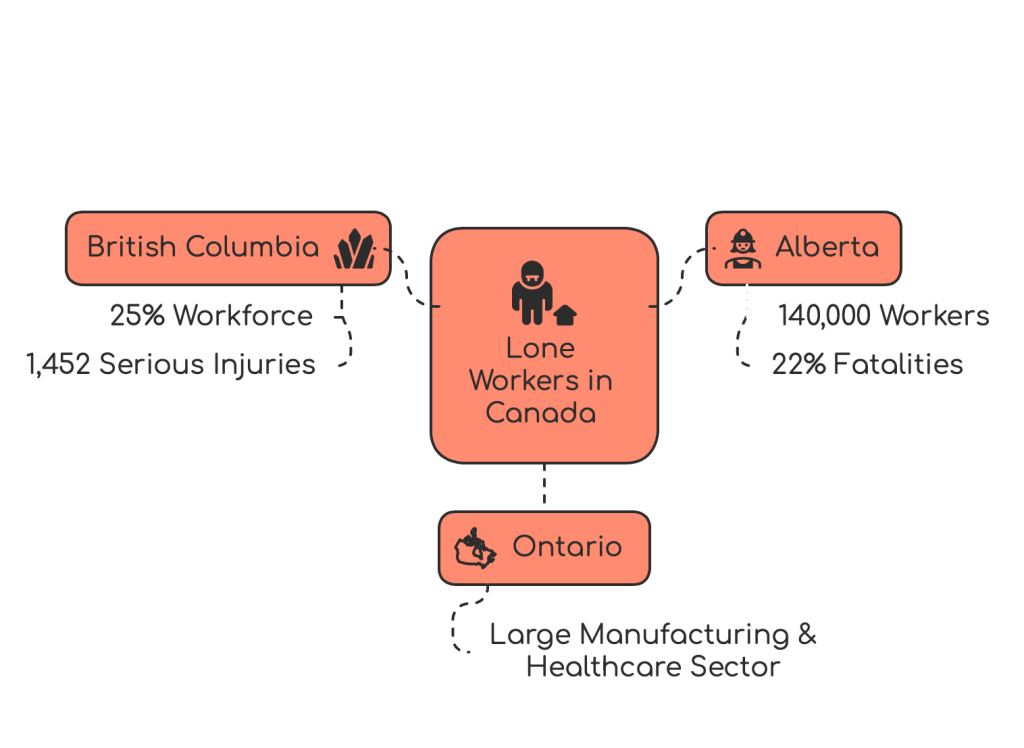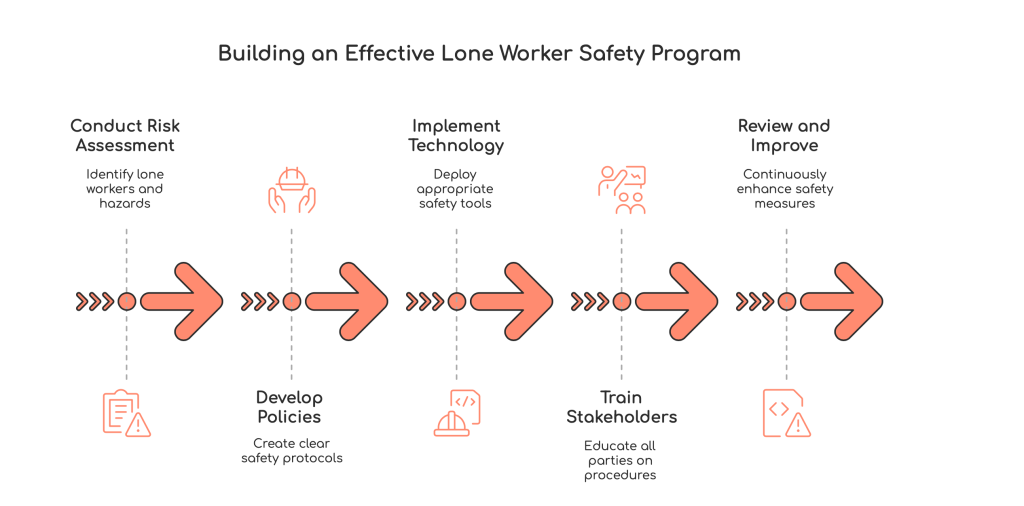The Ultimate Guide to Lone Worker Safety: Protecting Canada’s Remote and Solo Employees | ProTELEC Checkmate

Why Lone Worker Safety Matters in Canada
Have you ever found yourself working completely alone, perhaps in a remote location or during off-hours, and wondered:
“What would happen if something went wrong right now?”
You’re not alone in that concern.
Every day across Canada, millions of workers find themselves in exactly this position – working independently without direct supervision or immediate support nearby.

As the team behind ProTELEC Checkmate lone worker safety app, we’ve seen firsthand how proper lone worker protection isn’t just a nice-to-have—it’s a critical necessity that saves lives. Whether you’re a safety manager trying to protect your team, an employer navigating compliance requirements, or a lone worker yourself seeking better safeguards, this comprehensive guide will provide the essential knowledge you need.
In Canada alone, an estimated 15-20% of our workforce qualifies as “lone workers” across industries ranging from healthcare and utilities to transportation and retail. That translates to millions of Canadians who face unique safety challenges every day.
Even more concerning, statistics show that 68% of companies with lone employees have experienced a safety incident involving a lone worker in just the past three years.
In this guide, we’ll explore everything you need to know about lone worker safety in the Canadian context: legal requirements, innovative safety solutions, industry-specific challenges, and practical steps to create a robust lone worker safety program. By the end, you’ll have a clear roadmap for protecting those who work alone.
What Is a Lone Worker? Definition & Importance in Lone Worker Safety Programs
Before diving deeper, let’s clarify exactly what we mean by “lone worker.” According to the Canadian Centre for Occupational Health and Safety, a lone worker is defined as someone who “works alone at a job site in circumstances where assistance would not be readily available” and who “cannot be seen or heard by anyone else” during their work.
In practical terms, this includes:
What these diverse roles share in common is the absence of immediate help in case of emergency. If a lone worker experiences an accident, medical issue, or security threat, the consequences can be far more severe simply due to delayed response.
The Legal Landscape: Canadian Lone Worker Regulations
As a Canadian employer or safety professional, understanding your legal obligations for lone workers is crucial. While there is no single unified “lone worker law” in Canada, employers across all jurisdictions have a general duty to protect employees, including those working alone.
Federal Regulations
Part II of the Canada Labour Code and Canada Occupational Health and Safety Regulations require employers to ensure worker safety but do not outright prohibit working alone except in specific high-hazard tasks. Federal regulations mandate that certain jobs (like confined space entry, some electrical work, or work with drowning hazards) must not be done solo or must have a safety watch.
In all cases, employers must take “every reasonable precaution” for their workers’ safety. This general duty clause is the foundation upon which specific lone worker safeguards are built.
Provincial Regulations
| Province | Key Requirements | Official Resource |
| British Columbia | Written procedures for checking worker well-being; Regular contact and shift-end check required | WorkSafeBC Guidelines |
| Alberta | Hazard assessments, safety measures, communication systems, scheduled contacts | Alberta OHS Code |
| Saskatchewan | Risk identification and practical steps to eliminate/reduce hazards | Saskatchewan Requirements |
| Manitoba | Documented procedures based on risk assessment; Reliable communication systems | Manitoba Regulations |
| Ontario | No specific section but requires “every precaution reasonable in the circumstances” | Ontario OHS Act |
| Quebec | Workers in isolated environments must have “efficient means of surveillance” | Quebec OHS Regulations |
| Atlantic Canada | Varies from written procedures to Codes of Practice for Working Alone | NL OHS Regulations |
Provinces with Highest Impact
Statistical data shows that certain provinces have a higher concentration of lone workers due to their industrial composition and geography:
- British Columbia: With extensive natural resource operations in remote areas, BC has approximately 25% of its workforce classified as lone workers at some point. The province recorded 1,452 serious injuries to lone workers between 2018-2022, leading to some of the country’s most comprehensive regulations.
- Alberta: The oil and gas sector employs over 140,000 workers, many working in isolated locations. Alberta’s OHS data shows that 22% of workplace fatalities involved workers who were alone at the time of incident, making their hazard assessment requirements particularly critical.
- Ontario: Despite having less specific lone worker regulations, Ontario has the highest absolute number of lone workers due to its population size. Manufacturing and healthcare sectors account for 65% of lone worker incidents in the province.

We’ve seen many organizations caught off-guard by these regulations, especially those operating across multiple provinces. The key takeaway is that regardless of where you operate in Canada, you have legal obligations to protect lone workers through documented procedures, appropriate monitoring, and emergency response systems.
Top Lone Worker Safety Risks to Monitor and Prevent
Understanding the specific risks lone workers face is essential for developing effective safety measures. Based on both statistical data and real-world experience, these are the primary dangers:
1. Accidents and Injuries Without Immediate Help
For lone workers, even minor accidents can become serious emergencies when help is delayed. Consider a maintenance mechanic who becomes trapped in machinery, or a field worker who slips and sustains an injury in a remote location. Without colleagues nearby to assist or call for help, a relatively minor incident can quickly escalate.
Real Example: In 2019, a lone maintenance worker in British Columbia suffered a severe injury when equipment he was servicing activated unexpectedly. Because he was working alone after hours, he wasn’t discovered until the next morning shift arrived—resulting in significantly worsened medical outcomes that could have been prevented with immediate response.
2. Medical Emergencies While Isolated
Statistics show approximately 10,000 cardiac arrests occur in Canadian workplaces annually. For lone workers experiencing a sudden health crisis, survival rates drop dramatically without immediate assistance. The survival rate is only 5-7% if relying solely on emergency services response time, compared to much higher rates when colleagues are present to provide initial aid.
3. Violence and Security Threats
Workers who interact with the public alone or handle cash/valuable items face heightened risks of robbery or assault. The tragic case of Grant De Patie, a gas station attendant working alone at night who was killed during a “gas-and-dash” incident, led to important regulatory changes in British Columbia (Grant’s Law) requiring additional protections for late-night retail workers.
4. Environmental and Geographical Hazards
Many lone workers operate in challenging environments—extreme weather, remote wilderness, or hazardous locations. Utility workers, environmental researchers, and field technicians can face natural dangers ranging from wildlife encounters to sudden weather changes. Without backup, even experienced professionals can find themselves in life-threatening situations.
5. Psychological Stress and Mental Health Impacts
Often overlooked but increasingly important is the psychological burden of working alone. Extended isolation, responsibility without support, and the constant awareness of vulnerability can create significant stress. This can impair decision-making and increase accident risk through distraction or fatigue.
Industry-Specific Lone Worker Safety Challenges
Different sectors face unique lone worker safety challenges requiring tailored approaches:
| Industry | Key Risks | Recommended Solutions |
| Healthcare & Social Services |
• Violence from unstable clients • Medical emergencies while isolated • Unpredictable home environments |
• Duress codes (verbal signals indicating danger) • GPS tracking with panic buttons • Strict check-in protocols before/after visits |
| Utilities & Infrastructure |
• Remote locations with limited access • Environmental hazards • Dangerous equipment • Extreme weather conditions |
• Satellite communication devices • Automated check-in systems • Man-down detection technology • Weather monitoring alerts |
| Retail & Service Industries |
• Robbery risks • Customer confrontations • Late-night security threats |
• Security cameras with remote monitoring • Panic buttons • Policies to minimize cash handling • Physical barriers or double-staffing |
| Transportation & Delivery |
• Vehicle accidents in remote areas • Delivery to high-risk locations • Fatigue from long hours • Violence during deliveries |
• GPS tracking systems • Driver alertness monitoring • Scheduled check-ins • Route risk assessments |
Technology Solutions: The Evolution of Lone Worker Safety Apps & Protection Technology Solutions
Technological advances have dramatically improved lone worker safety options in recent years:
Comparing Lone Worker Safety Technologies
| Technology Type | Key Features | Best For | Limitations |
| Mobile Safety Apps (A cost-effective and widely adopted solution for work alone monitoring, especially in urban settings.) |
• GPS location tracking • Timed check-in alerts • Panic buttons • Automatic fall detection • Two-way communication |
• Cost-conscious organizations • Urban environments • Workers who already use smartphones • Multiple safety functions in one device |
• Requires cellular coverage • Battery life concerns • May not be rugged enough for harsh environments |
| Dedicated Safety Devices |
• Intrinsically safe designs • Extended battery life • Satellite connectivity options • Man-down detection • Discreet wearable formats |
• High-risk environments • Explosive/hazardous areas • Remote locations • Public-facing workers needing discretion |
• Higher cost than app-based solutions • Additional device for workers to carry • May require specialized training |
| 24/7 Monitoring Services |
• Professional emergency coordinators via our remote worker emergency alert system • Predetermined escalation protocols • Emergency services integration • Real-time audio assessment • Multi-channel communication |
• High-consequence environments • Organizations wanting full outsourcing • Workers in very high-risk situations |
• Monthly service costs • Reliance on third-party response • Potential for false alarms |
These technologies can be used individually or in combination to create a comprehensive safety system tailored to your organization’s specific needs and risk profile. We’ve seen companies reduce emergency response times from 30+ minutes to under 5 minutes by implementing these technologies—a difference that can literally save lives in critical situations.
Building an Effective Lone Worker Safety Program: A Step-by-Step Approach
Creating a comprehensive lone worker safety program involves several key steps:

1. Conduct a Thorough Risk Assessment
Start by identifying:
- Which employees work alone and when
- Specific hazards they face in their roles
- Existing controls and their effectiveness
- Gaps in current safety measures
A proper workplace safety risk assessment forms the foundation for all other safety measures. Document this process carefully to demonstrate due diligence.
2. Develop Written Policies and Procedures
Create clear, documented protocols covering:
- Definition of lone work in your organization
- Required safety measures for different risk levels
- Communication expectations and check-in procedures
- Emergency response protocols
- Responsibilities of workers, supervisors, and management
- A detailed emergency response plan for lone workers covering scenarios such as accidents, medical issues, and security threats.
Your written policy should be specific enough to provide clear guidance but flexible enough to adapt to different scenarios.
3. Implement Appropriate Technology Solutions
Based on your risk assessment, select and deploy technological tools that address your specific needs:
- Mobile apps for workers with reliable cell service
- Dedicated devices for high-risk or remote environments
- Monitoring services for emergency response
- One-touch emergency panic button for workers
Remember that technology should supplement, not replace, good safety management practices.
4. Train All Stakeholders Thoroughly
Provide comprehensive training for:
- Lone workers on using safety systems and handling emergencies
- Supervisors on monitoring procedures and emergency protocols
- Monitoring center staff on your specific requirements and escalation paths
Conduct regular refresher training and drills to ensure everyone remains familiar with procedures.
5. Review and Continuously Improve
Safety programs should evolve through:
- Regular policy reviews and updates
- Analysis of incident data and near-misses
- Feedback from lone workers themselves
- Adaptation to new technologies and best practices
The most effective programs constantly refine their approach based on real-world experience.
Lone Worker Safety Implementation Checklist
Implementing a successful lone worker safety program requires attention to detail and proper planning. Use this checklist to ensure you’ve covered all critical aspects:
| Implementation Phase | Critical Actions | Status |
| Initial Planning |
□ Identify all lone worker scenarios □ Conduct thorough risk assessments for each scenario □ Review applicable regulations for your province □ Establish budget for safety measures |
□ |
| Policy Development |
□ Create written lone worker policy □ Develop emergency response procedures □ Establish clear roles and responsibilities □ Define communication protocols and check-in requirements |
□ |
| Technology Selection |
□ Evaluate appropriate technology solutions □ Test solutions in your actual work environments □ Consider integration with existing systems □ Develop backup procedures for technology failures |
□ |
| Implementation |
□ Provide comprehensive training to all stakeholders □ Conduct drills and practice scenarios □ Phase in technology with adequate support □ Document all implementation steps |
□ |
| Ongoing Management |
□ Regularly review incident data and near-misses □ Update procedures based on lessons learned □ Conduct refresher training □ Stay current with regulatory changes |
□ |
Note: Customize this checklist based on your specific industry requirements and organizational structure.
Measuring Success: Key Performance Indicators for Lone Worker Safety
To ensure your lone worker safety program is effective, it’s important to track relevant metrics:
| KPI Category | Metrics to Track | Target |
| Incident Reduction |
• Number of lone worker incidents • Severity of incidents• Near-miss reports • Time between incidents |
Continuous reduction year-over-year |
| Response Effectiveness |
• Average emergency response time • % of emergencies responded to within target time • % of false alarms |
Response time under 5 minutes for critical incidents |
| Program Compliance |
• % of check-ins completed as required • % of employees properly using safety devices • Training completion rates |
>95% compliance |
| Program ROI |
• Cost savings from incident reduction • Insurance premium reductions • Productivity gains from safe solo work • Reduction in lost workdays |
Positive ROI within 12-18 months |
Why Choose Protelec Checkmate for Your Lone Worker Safety Needs
When it comes to protecting your lone workers, you need a solution that’s reliable, comprehensive, and designed for Canadian requirements. Here’s what makes Protelec Checkmate the trusted choice for lone worker safety:
Our Complete Lone Worker Protection System
At Protelec Checkmate, we offer a fully integrated approach to lone worker safety, including lone worker compliance software tailored to meet provincial regulations:
CheckMate Safe Alone App: Our lone worker monitoring app provides essential safety features including:
- GPS location tracking with precision mapping
- Customizable check-in schedules based on risk level
- One-touch emergency alerts with location data
- Fall detection and no-motion sensing capabilities
- User-friendly interface designed for worker compliance
Emergency Monitoring Centre: Our Canadian-based monitoring center provides:
- 24/7/365 monitoring and emergency response coordination
- Trained staff familiar with Canadian geography and emergency services
- Customized escalation protocols tailored to your organization
- Detailed incident reporting and documentation
Implementation Support: We don’t just provide technology – we partner with you through:
- Comprehensive risk assessment consultations
- Policy development assistance aligned with provincial regulations
- Thorough training programs for both workers and supervisors
- Regular program reviews and optimization
Canadian Expertise
As a Canadian company, we understand the unique challenges of keeping lone workers safe across our vast geography:
- Solutions for both urban environments and remote wilderness locations
- Compliance expertise with all provincial regulations
- Experience with Canada’s diverse industries and workplace scenarios
- Technology adapted for Canadian climate and geographical challenges
Client-Centered Approach
We believe in building lasting partnerships with our clients through:
- Customized solutions based on your specific operational needs
- Flexible implementation to accommodate your organization’s size and structure
- Ongoing support and consultation as your needs evolve
- Regular check-ins to ensure optimal system performance
Getting Started
Taking the first step toward better lone worker protection is simple:
- Consultation: Contact us for an initial assessment of your lone worker safety needs
- Solution Design: We’ll recommend the right combination of tools and services
- Implementation: Our team will help you deploy your customized safety system
- Ongoing Support: We provide continuous monitoring, maintenance, and program refinement
Contact Protelec Checkmate today to learn how we can help protect your lone workers with solutions designed specifically for Canadian organizations.
Conclusion: Why Lone Worker Safety Programs Are a Must in Canada
The statistics are clear: lone workers face significant risks that require specialized safety approaches. With approximately 15-20% of Canada’s workforce qualifying as lone workers, and 68% of companies with lone employees reporting safety incidents involving lone workers in recent years, the need for robust protection is undeniable.
By understanding the risks, implementing appropriate technologies, developing clear policies, and fostering a strong safety culture, organizations can significantly reduce those risks and ensure their lone workers return home safely every day.
Remember that lone worker safety is not just about compliance—it’s about ensuring that every employee, whether they work in a busy office or a remote location, has the same level of protection and support. It’s about recognizing that no worker should ever be truly “alone” when it comes to safety.
If you’re ready to take the next step in protecting your lone workers, start with a thorough risk assessment of your current operations and explore the technology solutions that best fit your specific needs. The investment in proper lone worker protection isn’t just a legal obligation—it’s a moral imperative and a sound business decision that protects your most valuable asset: your people.
Additional Resources
- Canadian Centre for Occupational Health and Safety – Working Alone Guide
- How to Protect Lone Workers With a Safety Management Program
- Lone Worker Guide: Reducing Injury and Risk
Want to learn more about how Protelec Checkmate can help protect your lone workers with industry-leading safety solutions? Contact us today for a free consultation and demonstration of our comprehensive lone worker safety platform.
